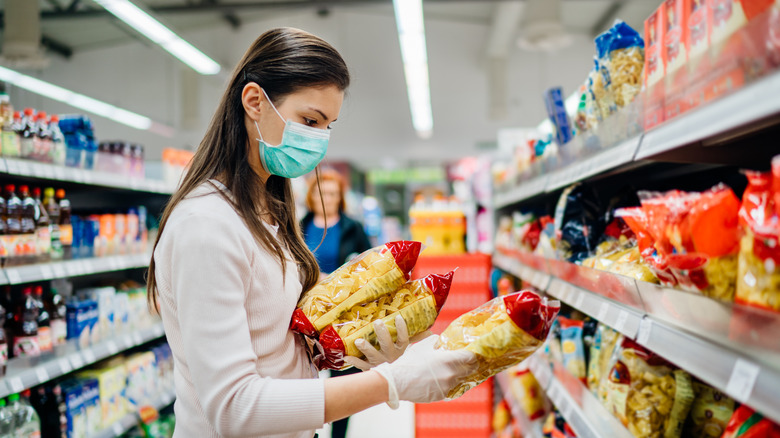Why You May Be Paying The Same Price For Less Food At The Grocery Store
As each year passes, it feels like you get a bit less for your money. If you believe you have noticed the quantity of milk, cereal, juice, and more steadily falling while sticking to the same price, you might have witnessed "shrinkflation." According to Medium, this economic phenomenon falls under the category of inflation. With inflation, you expect to see the price of goods increasing as time goes along. Shrinkflation operates on the same principles and usually only occurs in the food and beverage industry. In this situation, the price of an item stays the same, while the amount of the food drops. A noticeable moment of shrinkflation in recent memory occurred when Häagen-Dazs trimmed down their ice cream cartons from 16 ounces to 14 ounces in 2009 (via Economics Help).
When shrinkflation hits, usually two factors have led to the change. According to Wall Street Mojo, increased manufacturing costs and strong competition cause prices to stagnate while sizes fall. Shrinkflation ends up as a barely noticeable phenomenon, but eventually, consumers catch up with the differences and lose brand confidence with products that face this style of inflation. It may also cause other hidden forms of inflation, and further destabilize the market in ways no one intended. Shrinkflation can hit anywhere, but grocery stores face a particular vulnerability. It's something you may have recently noticed in your very own grocery aisle.
It's not in your head; some product sizes are shrinking
According to CBS News, food manufacturers have seen an uptick in food prices due to low employment numbers, supply chain shortages, and resource shortages. As a result, they have to adjust the cost of their products in order to rake in a profit, and have to decide to either raise prices on their goods or shrink their current packaging and offer consumers less at the same price. Many companies opt to slightly reduce packaging while keeping prices the same, assuming the average person won't notice a slight weight change in their foods and drinks. Shoppers have noticed shrinkflation on a wide variety of goods, ranging from paper towels to pet food (from companies like Royal Canin) to chocolate. Recently, Tillamook ice cream company announced it would reduce pint sizes from 56 ounces to 48 ounces (via Tillamook).
As businesses adapt to the current environment, the current market inflation should level out and experts predict that you should expect normal prices and product sizes to return later in the year, as experts told CBS News. As the economy starts to boom, demand for products should rise sharply, creating a supply bottleneck, so you have the potential to see shrinkflation get even worse before it gets better. For now, keep shopping smart and keep shrinkflation in mind next time you need to stock up.

